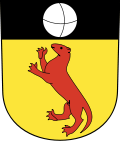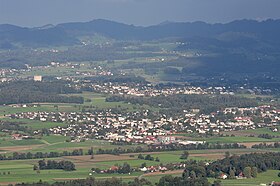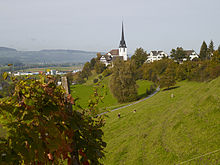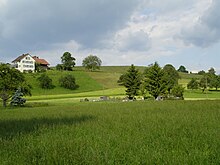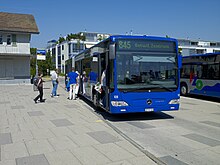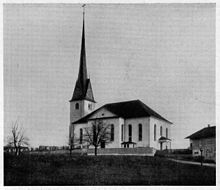Gossau ZH
| ZH is the abbreviation for the canton of Zurich in Switzerland and is used to avoid confusion with other entries of the name Gossau . |
| Gossau | |
|---|---|
| State : |
|
| Canton : |
|
| District : | Hinwil |
| BFS no. : | 0115 |
| Postal code : | 8614 Bertschikon (Gossau ZH) 8624 Grüt (Gossau ZH) 8625 Gossau ZH 8626 Ottikon (Gossau ZH) |
| UN / LOCODE : | CH GOS |
| Coordinates : | 699 665 / 240554 |
| Height : | 455 m above sea level M. |
| Height range : | 439-579 m above sea level M. |
| Area : | 18.26 km² |
| Residents: | 10,222 (December 31, 2018) |
| Population density : | 560 inhabitants per km² |
|
Proportion of foreigners : (residents without citizenship ) |
14.4% (December 31, 2018) |
| Mayor : | Jörg Kündig ( FDP ) |
| Website: | www.gossau-zh.ch |
|
View from the Pfannenstiel, |
|
| Location of the municipality | |
Gossau [ˈɡoːsau̯] (in the Zurich German local dialect Goossau [ˈɡosːæu̯] ) is a municipality in the district of Hinwil in the Swiss canton of Zurich . It is located in the Zurich Oberland , in the upper Glatttal between Wetzikon and Forch .
geography
Gossau borders on the Uster district in the west, Wetzikon in the north, Bubikon in the east and Grüningen in the south . The localities resp. Wachten Bertschikon , Grüt , Ottikon , Herschmettlen and Gossau-Dorf . There are also individual hamlets such as Hellberg or Brüschweid.
Gossau and its Wachten are embedded in a landscape shaped by over 150 drumlins , a remnant from the Ice Age. The settlements gradually developed on the wooded hills and in the swamps.
The air distance to the city of Zurich is 18 kilometers, the municipal border is 27.2 kilometers long, state and municipal roads are 98 kilometers and land roads are 120 kilometers. 66.4% of the municipal area is used for agriculture, 14.1% is covered with forest, 5.3% are roads and 13.7% are residential areas, water bodies take up 0.1% of the area (2010).
coat of arms
Blazon :
- In gold, a soaring red otter and a black shield head covered with a silver ball
The otter was taken from the old Ottikon coat of arms , the silver ball stands for Gossau-Dorf . The municipal coat of arms was introduced in 1930 and replaced a more complex coat of arms that also contained elements for the districts of Herschmettlen, Bertschikon and Grüt.
The otter in the coat of arms of the Wacht Ottikon was chosen by the political municipality of Gossau as the central motif for its municipal coat of arms, because this shield motif is the only one of the Gossau coat of arms that can be traced back to Gossau. The depiction of the otter goes back to a noble family resident in Ottikon and thus from Gossau.
Coat of arms of Gossau Dorf
The silver ball with a yellow ribbon on a black background also goes back to a noble family, namely the coat of arms of the Schmid family from Wetzikon . Offshoots of this sex are attested from 1204 in Zurich and have since provided mayors, councilors and governors. From 1627 the Schmids appear as owners of the castle and manor Kempten (Wetzikon), with which they also come into the possession of the Helfereipfrund Gossau (the auxiliary priests lived in a helper). In this way, members of the family feel at home in Gossau and in the 17th century even rose to become the village's elite.
population
| Population development | ||||||||||||||||||||
|---|---|---|---|---|---|---|---|---|---|---|---|---|---|---|---|---|---|---|---|---|
| year | 1634 | 1730 | 1870 | 1910 | 1941 | 1960 | 1970 | 1980 | 1990 | 2000 | 2010 | 2011 | 2012 | 2013 | 2014 | 2015 | 2016 | 2017 | 2018 | 2019 |
| Residents | 875 | 1,649 | 3,089 | 2,339 | 2,387 | 3,276 | 4,789 | 4,892 | 7'157 | 8,796 | 9,599 | 9,681 | 9,754 | 9,811 | 9,791 | 9,744 | 9,791 | 9,937 | 10,198 | 10,254 |
There are 5,465 households in Gossau (2016). The proportion of foreigners is 14.59% (2016). Tax rate (excluding churches): 219%. (2016)
religion
On December 31, 2016, 42.6% of the population belonged to the Evangelical Reformed Church and 24.4% to the Roman Catholic Church .
The Free Church of Chrischona and the New Apostolic Church are also represented in Gossau .
politics
legislative branch
The voters are the highest body of the political community. They elect the local council, the auditing commission, the social welfare office and decide at the ballot box or in the local assembly about the most important business of the community.
In the 2019 National Council elections, those eligible to vote from Gossau voted with the following party strengths: SVP 36.1%, FDP 14.3%, GLP 11.2%, GP 10.2%, SP 9.8%, EVP 7.1%, EDU 4 , 3%, CVP 3.9%, BDP 2.1%, AL 0.4%, SD 0.0% and other 0.6%.
executive
Every four years, those entitled to vote elect a council of seven (including the president). The mayor is Jörg Kündig (FDP, as of December 2017).
Cantonal Council
Gossau is represented in the Zurich Cantonal Council by: Cornelia Keller (BDP), Jörg Kündig (FDP), Beat Monhart (EVP), Elisabeth Pflugshaupt (SVP) and Daniel Wäfler (SVP).
Municipal council
The mayor is Jörg Kündig (FDP, as of December 2017).
| Members of the Gossau Municipal Council (2014-2018) | |||
|---|---|---|---|
| Surname | Taking office | function | Political party |
| Jörg Kündig | 1994 | Mayor | FDP |
| Daniel Baldenweg | 1998 | Building construction and planning | EPP |
| Salvatore Giorgiano | 2014 | safety | independent |
| Marc Huber | 2002 | Civil engineering | independent |
| Elisabeth Pflugshaupt | 2014 | Properties, businesses, culture and sports | SVP |
| Sylvia Veraguth Bamert | 2010 | society | PFP (Political Women's Panel Gossau) |
| Heinrich Wintsch | 1990 | environment | SVP |
history
Place name
The place name "Gossau" comes from the time of the Alemannic conquest. It goes back to Old High German Gôʒʒes ouwa , which means " Au des Gôʒʒo" and is reminiscent of the Alemannic settler who built his farm here on or on marshy terrain.
Early history and the Middle Ages
The earliest traces of settlers on the territory of today's municipality of Gossau date from the Bronze Age , approx. 2200 to 800 BC. The findings are sparse and indicate at most a small village far away from larger settlements. More concrete are the traces of the Celts , which suggest a permanent settlement of Gossau and its surroundings. During the Roman era, Gossau remained in the slipstream of history. The area was obviously not completely untouched by Roman influences, as the discovery of a coin from the late period of Roman rule in 1994 shows.
The mostly peaceful immigration of the Alamanni in the early 7th and 8th centuries provides for the first time reliable information about continuous settlement of Gossau. The Christianization of the population at that time is connected with the seizure of power by the monasteries, which regularly document their activities. The oldest document from Gossau comes from 745: In that year the powerful Alemannic Beata Landolt clan sold their land in this area to the St. Gallen monastery. The Gossau hamlet of Jungholz was later built on the spot.
As was customary in the feudal system of the High Middle Ages, today's Gossau municipality repeatedly belonged to different masters: The St. Gallen Monastery expanded its land here between 745 and 777, built the first church in today's Gossau-Dorf district and founded the largest parish in the Zurich Oberland . The rulership and basic rights lay alternately in secular and ecclesiastical hands. In 1262 the Habsburgs raised the neighboring Grüningen to the seat of the bailiff, making Gossau a subject of the Landgraviate of Grüningen. In 1408 the city-state of Zurich took over the rulership rights over the Vogtei Grüningen and kept them until the end of the Ancien Régime in 1798. An important landlord who also owned the rights to the Gossau church property was the Rüti monastery from 1414 .
During the Reformation, which began its victory march under the influence of Huldrych Zwingli from 1517, the Rüti monastery was stormed by rebellious farmers, including many from Gossau. A little later the manor in Bubikon , which had some lands in Gossau as a fief, was also hit . In 1525 the secession from the Catholic Church reached its climax, the monasteries were dissolved. The population of Gossau was open to the Reformation movement. The Anabaptists were strongly represented here , a radical wing of the reform movement that contradicted Zwingli on some religious issues. Under her leadership, there were uprisings against the city-state of Zurich, in which the abolition of serfdom , small tithe and compulsory service was demanded. The center of the rebellion was the county of Grüningen and especially Gossau, which welcomed many of the Anabaptists persecuted by Zurich. Eventually the movement was crushed. Their leaders, including Jakob Falk from Gossau, were drowned in the Limmat in 1527 and 1528.
Modern times
18th and 19th centuries
The history of the Political Community of Gossau begins with the military occupation of Switzerland in 1798 by Napoleonic troops and the Helvetic Republic . The newly formed political community, which is added to the Hinwil district, includes the civil parishes of the individual districts, today's Wachten. From 1803, during the so-called mediation , Napoleon had the centralistically ruled Helvetic Republic converted into the federalist Swiss Confederation under pressure from the old political forces. During this period, the rural population loses many of the rights that they gained in the Swiss Revolution. For example, only 40% of Gossau's citizens are eligible to vote.
Over the centuries, the majority of Gossau's population consisted of small farmers who mainly farmed according to the collective three-tier system . That changed noticeably in the 18th century when new, yield-increasing cultivation methods were introduced. In order to earn extra income, many of the smallholder families worked in the home industry from the middle of the 18th century . There is almost no house in Gossau that does not have at least one loom. Over time, over 60% of all smallholders in Gossau are working part-time as home weavers or home spinners. In contrast, the large farmers can afford to convert their farms to dairy farming, which spread in the first decades of the 19th century. The first cheese-making dairies are also founded in Gossau, and from 1830 onwards they spring up like mushrooms.
The triumphant advance of textile factories from the beginning of the 19th century gradually put an end to the home industry. By 1850, most home weavers in Gossau lose this important livelihood. Many of the smallholders affected are giving up their farms and looking for work in a factory or emigrating; others are switching to the silk industry, which relies on homeworkers for longer than the cotton industry. The abandoned farms are taken over by farmer families , mostly from the Bern region . They stay true to their rural roots, but enlarge the farms and dedicate themselves above all to the dairy industry.
In the course of industrialization, smaller spinning and weaving mills were also built in Gossau, the first in 1816 in a rear annex to the Krone tavern in the Bertschikon Wacht near Gossau . But Gossau cannot keep up with the large factories that opened their doors in the neighboring towns of Uster and Wetzikon around 1820. There is a lack of watercourses to generate the drive energy for a large number of machines. The silk industry, which rose to become the leading Swiss industry in the second half of the 19th century, does not find particularly good framework conditions in Gossau. Only two factories survived the turn of the century here: The Tannenberg silk spinning mill in Gossau-Dorf, founded in 1827 as a cotton factory, which closed in 1930, and the IDEWE silk spinning mill in Ottikon , which opened in 1873 and existed until 1973.
Gossau also remained a peripheral area for a long time in terms of traffic development. From 1836 onwards, the stagecoach from Zurich to Wald made a stop in the Gossau hamlet of Fuchsrüti. The village is easier to reach after the road from Stäfa via Grüningen and Ottikon to Wetzikon was opened in 1844 . In addition, the new Forchstrasse is inaugurated in 1853. However, Gossau is missing out on the opportunities offered by public transport. In 1857, for example, the municipality refused to extend the Glatthalbahn , which was opened in 1856, over Gossau's municipality. It wasn't until 1890 that something happened again: some municipalities in Zurich's Oberland are planning to set up electrically operated overland trams, which on the one hand connect the municipalities along the Glattalbahn with those on Lake Zurich and on the other hand ensure a connection to the Swiss railway network. When planning the Wetzikon-Meilen-Bahn (WMB), Gossau threatens to be left behind once more. However, the Gossau Cantonal Council Widmer-Heusser asserts that the districts of Gossau-Dorf , Grüt and Ottikon receive WMB stations. The overland trams were not economically successful, and the WMB, which opened in 1903, had to cease operations in 1950. Their lines are taken over by buses.
20th century


In 1914 the great nations of Europe started the First World War. Switzerland is also mobilizing to protect its borders. It is widely believed that the war will not last long, and therefore misses building a solid war economy. This is all the more serious as Switzerland is 40 percent dependent on imports for its food supply. Many families whose breadwinners are doing military service are in dire straits. Hunger and poverty are rampant. Like all municipalities in Switzerland, Gossau is also obliged to give horses and wagons as well as hay and straw to the military on orders. From 1917, food was rationed. Every municipality is required to create additional cultivation areas for potatoes. For this purpose, Gossau is drying the Moosried in Ottikon. Hunger and poverty are driving social tensions in the country to a climax. In November 1918 they went on a state strike . While numerous workers in industrial centers in rural and urban areas are on strike, Gossau remains calm.
In the interwar period, the Gossau population suffered from oppressive poverty. The largest local employer, the Tannenberg silk factory, closed in 1930. In the same year there was also a ray of hope: Accum AG, a manufacturer of heating appliances, settled in Gossau-Dorf and took over the role of the silk factory.
Switzerland is better prepared for the Second World War. Despite food rationing, nobody in rural Gossau has to go hungry. The cultivation battle , planned by Traugott Wahlen , Professor of Agriculture and later Federal Councilor, left the most traces here . In order to be able to grow more arable crops, the huge Gossauer Riet - at that time a magnificent natural oasis - is being renovated . In 1941, the year of the war, the village's economy grew with a mushroom growing business, popularly known as "Mushrooms".
During the boom of the 1950s, the canton of Zurich became the engine of the economic upswing and therefore attracted many people. The growth falls less on the large urban centers than on the landscape. Gossau also recorded a relatively strong increase in population. Between 1941 and 2012 the number of residents increased from 2,387 to 9,754. Especially after 1960 there were many newcomers who appreciate the quiet residential areas in the rural village. During this time, the village image changes quickly and permanently. Many new residential areas are being built, especially in the districts of Gossau-Dorf and Grüt. In the other wakes, however, growth is more leisurely.
Hand in hand with demographic growth, the municipality's economy is also changing. Agriculture is experiencing a decline, while the commercial and especially the service sector is growing. This development accelerated in the last three decades of the 20th century: While 124 farms were counted in Gossau in 1985, there were only 58 in 2010.
Economy and Transport
The traffic development, the population growth and the quality of living make the community of Gossau an interesting location for industry, commerce and service providers. Despite the rural surroundings, the cities of Zurich, Winterthur, Rapperswil and the international airport Kloten can be reached in 20 to 30 minutes by car. In 2005 there were 342 companies in Gossau, employing a total of 1967 people, mainly in the industrial, commercial and service sectors.
Public transport
Gossau does not have its own train station, but is connected to public transport via bus lines. The following bus lines exist, which are operated by the Zurich Lake and Oberland Transport Authority (VZO):
- 845 Uster station - Sulzbach - Bertschikon - Gossau - Uster station
- 862 Wetzikon station - Grüt - Gossau - Grüt - Wetzikon station (round trip)
- 867 station Wetzikon - Grüt - Gossau - Grüningen - Oetwil am See
Private transport
In the area of expressways, Gossau is accessible via the cantonal A52 (Forchautostrasse) and A15 (Oberlandautobahn to Uster). A finely branched cantonal and communal road network leads to every corner of the large community.
school
Gossau has managed schools. There are nine kindergartens, six primary schools and one upper school house spread across the municipality. The long or short-term grammar school can be attended at the Cantonal School Zürcher Oberland (KZO) in Wetzikon.
Attractions
reformed Church
The landmark of Gossau is the reformed church enthroned high above the community. It has a central font made of deep black marble. The first church was built on this site as early as the 8th century.
Catholic Church
Gerbel lookout point
One vantage point is the Gerbel near Herschmettlen: from this highest point in the Glatt valley one should (allegedly) be able to count 24 church towers.
Drumlin landscape
Of the more than 150 drumlins (ground moraine hills from the Ice Age) in the upper Glatt valley, 50 are located in the Gossau municipality. The drumlin Ottiker Büel in the Unterottikon watch is particularly typical.
Personalities
- Jakob Falk (* 15th or 16th century; † 1528), martyr of the Anabaptist movement
- Ernst Brugger (1914–1998), Federal Councilor
- Gerold Stahel (1887–1955), phytopathologist
- Jakob Zollinger (1931–2010) Dr. hc, village historian and chronicler
- Claudio Zanetti (* 1967), politician (SVP), member of the National Council, lives in Gossau
literature
- Jakob Zollinger: Gossau (ZH). In: Historical Lexicon of Switzerland .
- Gossau - your home, Volumes 1 to 12: Gossau history from the beginning to today - Historical walks: Six forays through the history of Gossau.
- Gossau - From bitter poverty to popular place of residence. Local history of the community of Gossau ZH
- Hermann Fietz: The art monuments of the canton of Zurich, Volume II: The districts of Bülach, Dielsdorf, Hinwil, Horgen and Meilen (= art monuments of Switzerland. Volume 15). Edited by the Society for Swiss Art History GSK. Bern 1943. DNB 365803049 .
- Arthur Stocker: My first 20 years.
- Bertschikon - A village through the ages
Web links
Individual evidence
- ↑ Permanent and non-permanent resident population by year, canton, district, municipality, population type and gender (permanent resident population). In: bfs. admin.ch . Federal Statistical Office (FSO), August 31, 2019, accessed on December 22, 2019 .
- ↑ Data on the resident population by home, gender and age (community profile). Statistical Office of the Canton of Zurich, accessed on December 22, 2019 .
- ^ Linguistic Atlas of German-speaking Switzerland , Volume V, 1b.
- ↑ «1805 a Gossau seal appeared for the first time, which contained the coats of arms of all five local guards. Two clay pipes for Herschmettlen , a silver ball for Gossau-Dorf, three red roses for Bertschikon, two bundles of reeds for Grüt and the otter for Ottikon. The patchwork coat of arms lasted until 1930. Then it was replaced by the now known otter with a silver ball over his head, the two symbols of Gossau-Dorf and Ottikon. " Zurich Oberland, July 14, 2014 .
- ^ Galliker, Hans-Rudolf and Binder, Thomas-Peter. Gossau - From bitter poverty to popular place of residence. Gossau 2014.
- ↑ https://statistik.zh.ch/internet/justiz_inneres/statistik/de/daten/gemeindeportraet_kanton_zuerich.html#a-content
- ↑ https://statistik.zh.ch/internet/justiz_inneres/statistik/de/daten/gemeindeportraet_kanton_zuerich.html#a-content
- ↑ https://statistik.zh.ch/internet/justiz_inneres/statistik/de/daten/gemeindeportraet_kanton_zuerich.html#a-content
- ↑ https://statistik.zh.ch/internet/justiz_inneres/statistik/de/daten/gemeindeportraet_kanton_zuerich.html#a-content
- ↑ https://statistik.zh.ch/internet/justiz_inneres/statistik/de/daten/gemeindeportraet_kanton_zuerich.html#a-content
- ↑ http://www.statistik.zh.ch/internet/justiz_inneres/statistik/de/aktuell/mitteilungen/2012/bev_2011.html (accessed on February 27, 2012).
- ↑ http://chrischona-gossau.ch/ (accessed on February 27, 2012).
- ↑ http://www.gossau-zh.ch/gossau/kirchen.html (accessed on February 27, 2012).
- ^ Portrait of the municipality of the Canton of Zurich. Retrieved April 18, 2020 .
- ↑ Mayor of Gossau. In: Zurich Oberland . March 30, 2014. Accessed March 30, 2014.
- ↑ Political stronghold in old strength. In: Zurich Oberland . April 5, 2011. Retrieved April 12, 2011.
- ↑ Lexicon of Swiss Community Names , ed. from the Center de Dialectologie at the University of Neuchâtel under the direction of Andres Kristol, Frauenfeld / Lausanne 2005, p. 399.
- ↑ Source for the entire history chapter: Galliker, Hans-Rudolf and Binder, Thomas-Peter. Gossau ZH, from bitter poverty to popular place of residence. Gossau 2014.
- ↑ zo-online.ch: Loss for local customers (Hinwil Gossau, ZO-Online) , accessed on April 16, 2010
- ↑ tagesanzeiger.ch: Jakob Zollinger - an Oberland Flarzbueb with a big heart - Zurich - tagesanzeiger.ch , accessed on April 16, 2010
